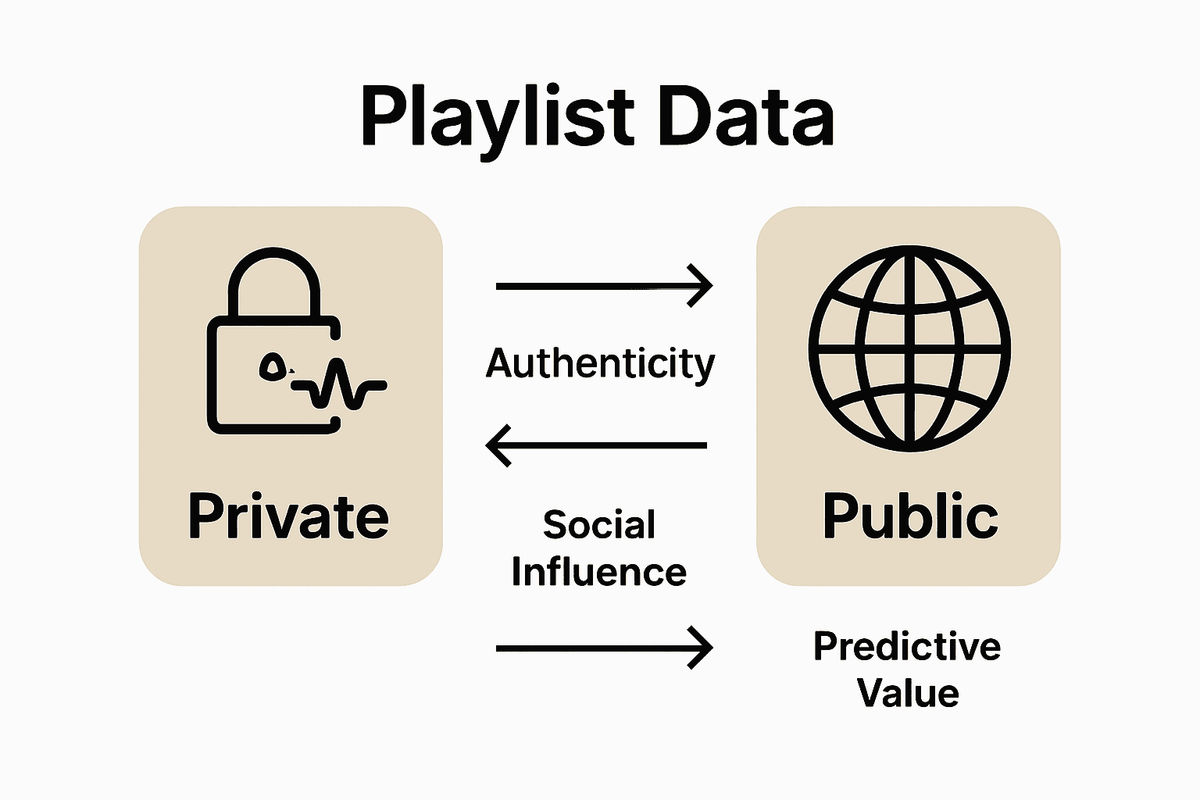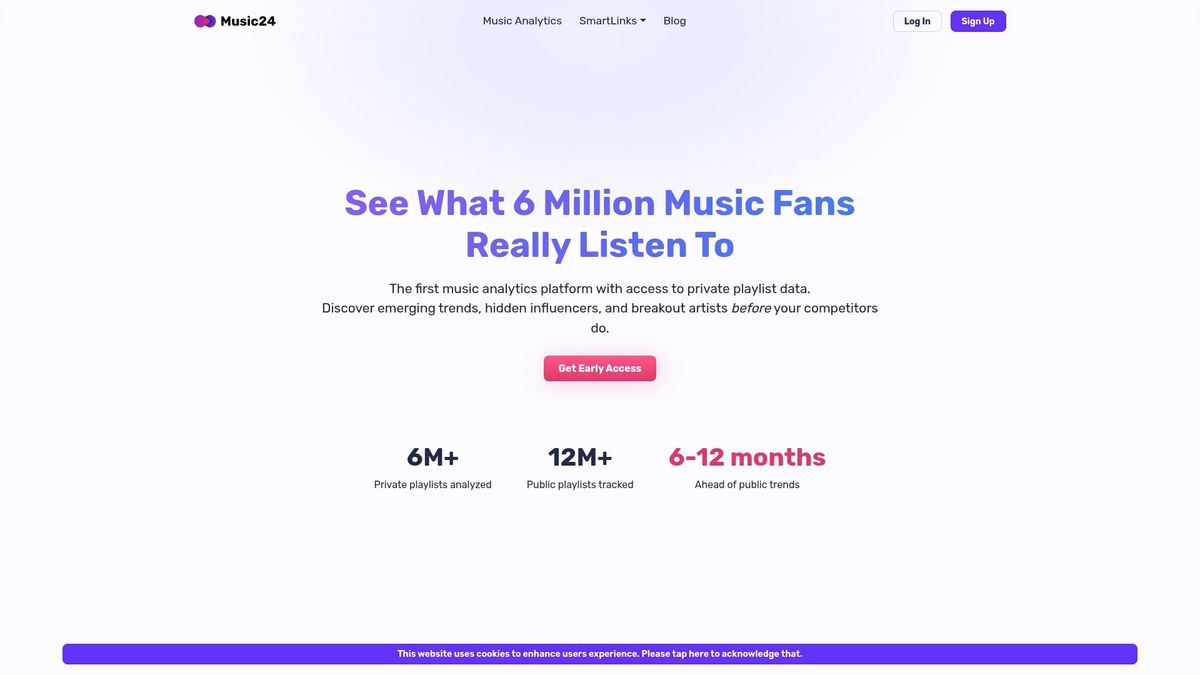Most listeners build playlists behind the scenes, but more than 80 percent of these collections remain private and unseen by the wider world. Understanding this hidden data is essential for anyone serious about truly knowing what drives listener choices and emerging music trends. By tapping into the world of private playlists, industry professionals can identify patterns and preferences that public data never reveals, offering a deeper look into genuine musical taste and early discoveries.
Table of Contents
- Defining Private Playlist Data In Music Analytics
- Key Differences: Private Versus Public Playlist Data
- How Private Playlist Analysis Uncovers Trends
- Industry Applications For Music Professionals
- Ethical, Legal, And Privacy Considerations
Key Takeaways
| Point | Details |
|---|---|
| Insight into Listener Behavior | Private playlist data reveals genuine listener preferences, uncovering trends that public metrics often overlook. |
| Predictive Capabilities | Analyzing private playlists allows professionals to forecast emerging music trends and identify breakthrough artists ahead of mainstream recognition. |
| Ethical Data Management | Ensuring robust privacy protections is essential when leveraging private playlist data to maintain user trust and comply with legal obligations. |
| Strategic Applications | Music industry professionals can enhance A&R discovery, marketing strategies, and artist development by utilizing insights from private playlist analytics. |
Defining Private Playlist Data in Music Analytics
Private playlist data represents the hidden landscape of listener behavior within music streaming platforms—a complex ecosystem of personalized music collections invisible to public metrics. Unlike public playlists shared on social platforms, private playlists are curated collections existing exclusively within a user's personal digital music environment, offering unprecedented insights into authentic listener preferences.
According to research by diva-portal, user playlist practices demonstrate significant behavioral diversity, with a critical underlying factor being user control. As music streaming services provide extensive, constantly evolving music libraries, playlist creation becomes a mechanism for listeners to actively shape and manage their musical experience. This user-driven approach transforms private playlists from mere song collections into dynamic personal narratives of musical taste and discovery.
Private playlist data analytics uncover nuanced patterns that traditional public metrics cannot capture. These collections reveal:
- Genuine listener preferences unfiltered by social performance
- Emerging genre blending trends
- Micro-geographical musical taste variations
- Early-stage artist discovery patterns
- Personalized listening behaviors across different contexts

By analyzing millions of anonymized private playlist configurations, music industry professionals can detect authentic listener behaviors before they manifest in mainstream charts or social metrics. This predictive capability provides a strategic advantage in understanding evolving musical landscapes and identifying breakthrough talent ahead of conventional discovery methods.
Key Differences: Private Versus Public Playlist Data
Private and public playlist data represent two distinct approaches to understanding music consumption, each offering unique insights into listener behavior. Public playlists are shared collections visible to all users, while private playlists remain personal and hidden, creating fundamentally different analytical landscapes for music industry professionals.
Research from arxiv highlights critical differences in playlist characteristics, demonstrating that public playlists often reflect social performance and curated external personas. In contrast, private playlists reveal unfiltered, authentic listening preferences. These private collections provide raw, unmanipulated data about genuine musical tastes that aren't influenced by social expectations or platform visibility.
Key distinguishing factors between private and public playlist data include:
- Authenticity Level: Private playlists show true listener preferences
- Social Influence: Public playlists are more likely to be curated for external perception
- Data Richness: Private playlists offer deeper behavioral insights
- Predictive Value: Private playlist data can forecast emerging trends more accurately

Thesis research from unipd.it further reveals the potential for extracting nuanced personal insights from playlist data, underscoring the significant analytical value of understanding these differences. By recognizing the unique characteristics of private versus public playlists, music industry professionals can develop more sophisticated strategies for artist discovery, audience targeting, and trend prediction.
Explore our comprehensive guide on understanding playlist data types to dive deeper into these critical distinctions.
How Private Playlist Analysis Uncovers Trends
Private playlist analysis represents a sophisticated method for decoding emerging musical landscapes, offering unprecedented insights into listener behavior that traditional metrics cannot capture. By examining millions of anonymized personal playlist configurations, music industry professionals can detect subtle trend indicators long before they manifest in mainstream charts or social platforms.
Research from epjdatascience highlights the nuanced differences between collaborative and personal playlists, revealing critical methodological approaches for trend detection. The study demonstrates how causal inference techniques can be applied to understand playlist coherence and behavioral patterns, providing a scientific framework for trend analysis that goes beyond surface-level observations.
Key trend detection strategies through private playlist analysis include:
- Genre Fusion Patterns: Identifying emerging cross-genre musical blends
- Micro-Cultural Listening Trends: Detecting localized musical preferences
- Emerging Artist Discovery: Tracking early adoption of new musicians
- Listener Behavior Evolution: Analyzing shifts in musical consumption habits
- Emotional Landscape Mapping: Understanding mood-based playlist constructions
By leveraging these sophisticated analytical approaches, music industry professionals can transform raw playlist data into strategic intelligence. Private playlist analysis provides a predictive lens into musical ecosystems, allowing for more nuanced understanding of listener preferences and potential breakthrough trends before they become widely recognized.
Explore our guide on discovering private playlist trends to gain deeper insights into this revolutionary analytical approach.
Industry Applications for Music Professionals
Private playlist data transforms how music industry professionals strategize, offering unprecedented insights that traditional analytics cannot capture. These granular datasets provide a direct window into listener behavior, enabling more sophisticated decision-making across multiple professional domains.
Research from arxiv highlights the potential of advanced music representation models, demonstrating how sophisticated data analysis techniques can unlock deeper understanding of music consumption patterns. By leveraging contrastive learning and metadata analysis, professionals can develop more nuanced approaches to music classification and similarity assessment.
Key industry applications of private playlist data include:
- A&R Discovery: Identifying emerging artists before mainstream recognition
- Marketing Strategy: Developing targeted promotional campaigns
- Playlist Curation: Understanding cross-genre listener preferences
- Artist Development: Tracking listener engagement and music evolution
- Revenue Optimization: Predicting potential streaming and licensing opportunities
Moreover, innovative approaches like those explored in mdpi demonstrate how knowledge graphs and reinforcement learning can further enhance playlist generation and music recommendation strategies. By transforming raw playlist data into actionable intelligence, music professionals can make more informed, data-driven decisions that anticipate market trends and listener behaviors.
Learn more about the top music data sources in our comprehensive guide.
Ethical, Legal, and Privacy Considerations
Private playlist data represents a powerful analytical resource that demands rigorous ethical and privacy protections. Music industry professionals must navigate a complex landscape of data privacy, balancing innovative insights with fundamental user rights and legal compliance.
Research from thesis.unipd.it reveals significant privacy risks associated with seemingly innocuous music data. The study demonstrates how personal information can be inadvertently exposed through playlist analytics, underscoring the critical need for robust privacy safeguards and transparent data handling practices.
Key ethical considerations in private playlist data management include:
- Data Anonymization: Removing personally identifiable information
- User Consent: Obtaining clear, informed permission for data use
- Transparent Data Practices: Communicating exactly how data will be utilized
- Minimal Data Collection: Gathering only essential information
- Secure Data Storage: Implementing robust protection mechanisms
Interestingly, research from Spotify Research highlights how personal data can trigger meaningful user interactions, emphasizing the delicate balance between data utility and individual privacy. Responsible data professionals must continuously evolve their approach, prioritizing user trust and legal compliance while extracting valuable insights.
Review our comprehensive privacy guidelines for detailed protections.
Unlock the Power of Private Playlist Data for Your Music Strategy
The challenge many music professionals face today is understanding authentic listener behavior hidden within private playlists. This article highlights how private playlist data reveals real preferences, early artist discovery, and trend forecasting that public metrics alone cannot capture. If you struggle to identify true musical trends or rising talent before they reach mainstream awareness, leveraging private playlist insights is essential. Music24.com specializes in analyzing millions of anonymized private playlists to deliver actionable analytics on genre blending, micro-trends, and listener behavior.
Experience firsthand how uncovering these hidden patterns can transform your A&R decisions, marketing efforts, and artist development strategies. Stay ahead of your competition by accessing data that goes beyond public charts and social metrics.
Explore Music24’s platform for exclusive tools designed to harness the full value of private playlist data.

Ready to turn private playlists into your greatest competitive advantage Discover how Music24 helps you spot breakout artists, understand authentic audience tastes, and predict emerging trends before anyone else. Visit Music24.com now and start making confident data-driven decisions that power your success in the evolving music landscape.
Frequently Asked Questions
What is private playlist data in music analytics?
Private playlist data refers to curated music collections that are exclusive to individual users within music streaming platforms. This data provides insights into authentic listener preferences that are not captured by public playlist metrics.
How does private playlist data differ from public playlist data?
Private playlist data reflects true listener preferences without the influence of social performance, while public playlists are curated with external personas in mind. This makes private playlists richer in insights that can be used for trend prediction.
What trends can be detected through private playlist analysis?
Private playlist analysis can reveal emerging genre fusion patterns, localized musical preferences, early adoption of new artists, shifts in listener behavior, and mood-based playlist constructions, helping to forecast future music trends.
Why is private playlist data important for music professionals?
Private playlist data is essential for music professionals as it provides a comprehensive understanding of listener behavior, which can inform artist discovery, marketing strategies, playlist curation, and revenue optimization based on predictive insights.
Recommended
- Understanding Types of Playlist Data in the Music Industry - Blog - Music24.com
- Understanding Private Playlist Data Explained - Blog - Music24.com
- 7 Examples of Private Playlist Trends to Watch - Blog - Music24.com
- Understanding the Role of Playlist Data in Music Industry - Blog - Music24.com
- How Much Data Does YouTube Use? Streaming Guide Oct-2025 | SimCornerUSA How Much Data Does YouTube Use? Streaming Guide Oct-2025 | SimCornerUSA



